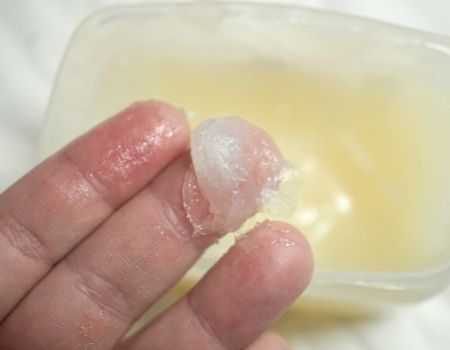More than likely, you have some in your medicine cabinet right now. We’re talking about petroleum jelly, which is often applied to the skin for discomfort or irritation. You wonder about what’s in that little tube or jar of jelly. Is it flammable?
Petroleum jelly could be flammable due to a byproduct known as white soft paraffin. A 2018 report from the BBC attributed dozens of deaths by fire to paraffin in skin creams. However, if it is stored and contained properly the risk of flammability is very low.

If you’re eager to learn more about white soft paraffins and the flammability of petroleum jelly, we’ll explain all that and more ahead. We’ll even provide some fire safety tips, so make sure you keep reading!
Table of Contents
What Is Petroleum Jelly? What Is It Used for?
Although you could identify a petroleum jelly product if you saw it, do you know what’s actually in that tube of Vaseline? Allow us to explain.
Petroleum jelly has many names, including multi hydrocarbons, soft paraffins, white petrolatum, and petrolatum. The hydrocarbons in petroleum are somewhat solid due to the high carbon number.
The first usage of petroleum jelly dates to the days of the Native Americans. Many, many years later, in 1872, Vaseline® first appeared on store shelves. Even to this day, Vaseline® is arguably the best-known brand of petroleum jelly.
What’s the point of petroleum jelly? Applying a small portion of the jelly on the skin can treat all sorts of ailments, everything from diaper rash to skin irritation to nosebleeds, genital rashes, and toenail fungus.
Here are some examples of products that use petroleum jelly.
Pet Care Products
If you have a feline friend and give them any hairball products, it’s likely that the product contains petroleum jelly. That’s also the case in dog paw moisturizers.
Surface Cleaners
Cleaning a variety of surfaces is one such feature of petroleum jelly. That’s why it’s a top ingredient in leather stain remover as well as makeup remover.
Fragrances and Candles
Those fragrances and candles you like to enjoy throughout the year also contain petroleum jelly. The jelly allows a candle to become softer so the candle can stick to the glass sidewalls better. The candle will also absorb the fragrance oil to enhance its scent.

Lubricants
From anti-seize assembling grease to light lubricating grease, bullet lubricant compounds, and even some vehicular lubricant, petroleum jelly is a popular lubricating product. It should not be used as a sexual lubricant.
Furniture Polish
Leather polish and mineral oil finish for wood both feature petroleum jelly. The polish usually doubles as a protectant too.
Hair Products
Petroleum jelly can improve the feel of the hair on your head and/or face. Combining it with pure beeswax makes a fantastic moustache wax. The jelly can also work as a hair pomade.
Skincare Products
One of the top uses of petroleum jelly is for better skincare. The jelly traps in moisture, so it’s usable on fingertips, lips, and skin that are dried out. Its heat-insulating properties are popular among swimmers who want to hold onto extra warmth when in the water.
Is Petroleum Jelly Flammable?
Considering that petroleum jelly is in so many everyday products, you must know whether it’s flammable. You can’t imagine that it is, right?
Petroleum jelly can be flammable.
Vaseline® made a statement on their website, writing that “no – Vaseline® Jelly is not flammable.” Vaseline® does identify petroleum as a flammable substance on their website.
The site also mentions that if you use and store Vaseline® properly, it isn’t flammable, as it would take temperatures of over 400 degrees Fahrenheit for flammable vapors to emit from a jar or tube of Vaseline.

This means that when set alight, Vaseline® could easily burn, feeding a fire and possibly contributing to its spread.
Yet that’s just Vaseline®. Although it’s the most popular, it’s far from the only petroleum jelly product on the market. These products usually contain a flammable ingredient, and that’s paraffin.
The Oxford Dictionary definition calls paraffin “a flammable, whitish, translucent, waxy solid consisting of a mixture of saturated hydrocarbons, obtained by distillation from petroleum of shale and used in candles, cosmetics, polishes, and sealing and waterproofing compounds.”
In other words, white soft paraffins are petroleum byproducts. They might not be in every product that contains petroleum, but they are in many.
A 2018 report from the BBC explored the cause of 38 UK fire-related deaths between 2010 and 2016. The BBC notes that even after publishing the report, that from November 2016 to 2018, eight more of these deaths occurred.
The common thread in all 46 deaths was the inclusion of paraffin in skin creams. This article, also from BBC, explains the nature of some of the deaths.
How the paraffin in petroleum jelly products can cause death varies. If you slather yourself in the jelly every night and then sleep in the same bedding and that bedding is near a flame, a fire can start that way.
The paraffin can even get saturated into your clothes if you use enough of it. Once again, all it takes is being near an open flame and you could catch on fire.
That’s what happened to one UK man who was profiled in the second BBC link. His name was Philip Hoe. In 2006, he used emollient cream on his skin and then lit a cigarette. When sparks spread from the lit cigarette onto his skin, he began burning. Up to 90 percent of his skin was covered in burns. He later died.
The BBC mentions that the Medicines and Healthcare Products Regulatory Agency or MHRA had requested that skincare products with paraffin have a fire risk warning printed on the jar or tube, but that occurred the year the BBC articles were published around 2018. Nothing seems to have come of it.
Many consumers do not appear to be privy to the risks that paraffin can carry…until it’s too late.
This problem is not only occurring in the UK, by the way. Although that’s where the breadth of the BBC’s research occurred, paraffins are in many US-sold skincare and haircare products as well.
Fire Safety Tips for Petroleum Jelly Products
We’re not saying to throw out all your petroleum or paraffin-containing products. You’d be left with very few skincare products if you did. You just have to get smart.
Being a savvy consumer is best for your health and that of your family members. Here are some fire safety tips to follow whenever using petroleum products.
Limit How Much Petroleum Jelly You Use at Once
Unless you have very dry skin, there should be no need to slather petroleum jelly all over your skin. A thin but even layer will trap in moisture. This will also keep your jar of Vaseline from running out so quickly so you don’t always have to run out and buy more.
Keep Petroleum Products Away from Sources of Heat or Flame
When storing petroleum jelly products, do so responsibly. Now that you know the risks of paraffins, keep your jar or tube of Vaseline away from any heat sources.
Storing these products in a medicine cabinet or a bedside drawer should be fine, as inside the cabinet or drawer is cool and dark.
Change Your Bedding Often If You Use Paraffin
Lots of people put paraffin creams on their bodies before going to bed so the stuff can moisturize their skin overnight. If this is something you do as well, then you ideally want to change your bedsheets the day after your overnight moisturizing session.
Remember, it’s the buildup of paraffin on sheets and/or clothing that can cause a fire. By changing your sheets after using skin cream on your skin, you can prevent that accumulation.
Test Your Fire Alarm Monthly
Now is a good time to delve into regular fire safety habits. Every month, drag out your ladder from the garage and go through each fire alarm throughout the house. From the basement to the top floor bedroom, check that each fire alarm is working.

If a fire ever does occur in your home, whether it’s caused by paraffins or otherwise, your fire alarm can alert you so you can make a quick escape.
Replace Fire Alarm Batteries One to Two Times Per Year
Ideally, you want to change your fire alarm batteries at least annually, perhaps twice a year depending on the model. You can only rely on the life-saving capabilities of a fire alarm if yours has working batteries.
If your fire alarm won’t stop chirping, a dead or dying battery is usually why.
Have a Fire Escape Plan
What would you and the rest of your household do if a fire did occur in your home? Having a contingency plan for this worst-case scenario can allow everyone to swiftly exit the house, keeping them alive.
Once you make a fire escape plan, it doesn’t hurt to review it every year, especially if you have very young kids. They’ll appreciate the refresher.
Stop, Drop, and Roll
Everyone grew up being told to stop, drop, and roll if they’re ever on fire. Hopefully, this isn’t a practice you ever have to put to use, but does stop, drop, and roll work?
Yes, it does, for a variety of reasons. When you stop rather than run, you’re prohibiting the amount of oxygen the fire is fed. A fire must have oxygen to spread, so when you staunch that, the fire slows.
By dropping face-down, you’re keeping oxygen from spreading to crucial areas such as your face. You’re also preventing the fire from burning in its usual upward direction, which can further slow the fire.
Rolling will smother the fire that might have already spread to your body, limiting its damaging effects. You don’t want to roll just once, but until you’ve put out the flames burning from your clothing.
Finally, petroleum jelly contains paraffins, which are highly flammable substances. Although petroleum jelly products such as Vaseline should be safe to use (if you do so properly, that is), you want to take heed of where and how you store these products and how much you put on your skin. Be safe out there!